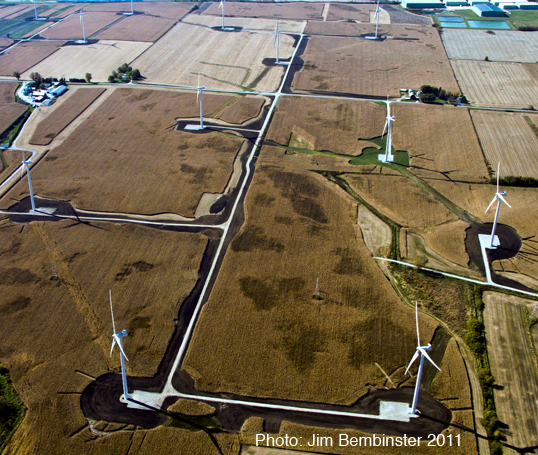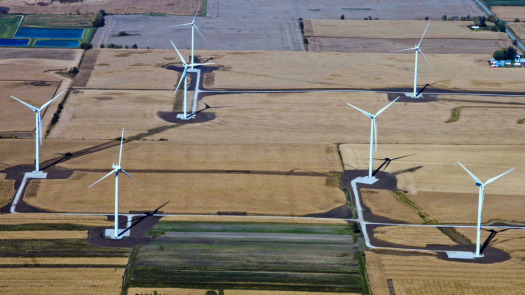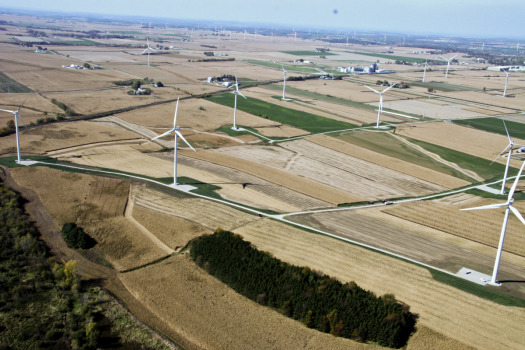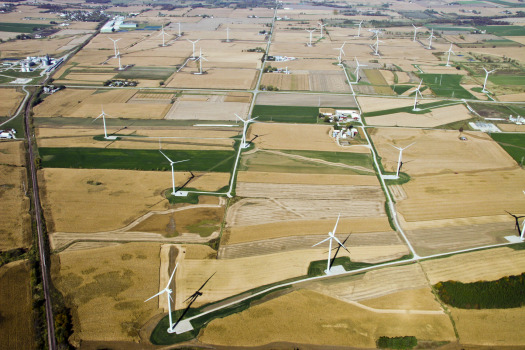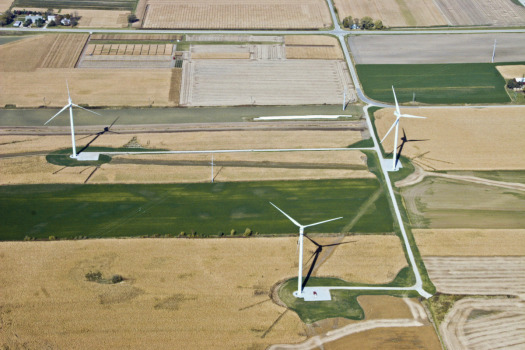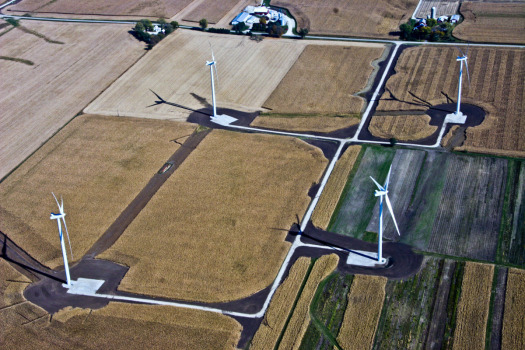Entries in wind farm field damage (2)
3/15/12 Farmers seeing the truth about wind developers:The lunch was free, but the contract you signed afterwards tied your land up for 50 years
From Five Questions to Ask Before Signing a Wind-Energy Lease
Source: Corn and Soybean Digest
March 15, 2012
1. How will the lease affect my farming operation?
A commercial wind project needs about 60 acres of land per megawatt (MW). But only 3% of that area — roughly three acres — is occupied by turbines, substations and access roads. The rest is a buffer zone to preserve wind flow. The lease should clearly state your rights to use the land for farming, grazing, development of subsurface minerals, hunting or other uses, Jambor-Delgado says.
Despite a relatively small footprint, a wind project can significantly affect farm operations, efficiency and production, says Dwight Aakre, North Dakota State University Extension farm management specialist.
Turbines and access roads can change field configurations, disrupting row orientation and creating inconvenient end rows or land fragments inaccessible to large equipment.
Field-drainage patterns may be altered. Center-pivot irrigation systems can be blocked. On grazing land, fences, gates and cattle guards may have to be changed.
“Aerial crop spraying is often an issue,” Aakre says. In the north, snow plowing can cause headaches for growers. “Those access roads have to be kept open, and if the snow piles up in the field it can take a long time to melt in the spring, delaying or preventing planting.”
Farmers should raise agricultural-production issues in the initial contract talks, says Dean Retherford of Halderman Farm Management, Lafayette, IN. Retherford has helped negotiate leases for several wind projects in northwest and west-central Indiana, involving 39 wind turbines on farms he manages.
“We learned to request input on the location of roads,” Retherford says. “And the wind companies found that landowners were more of a help than a hindrance” in site decisions, he says.
The lease should clearly state how you will be compensated if land is taken out of production or crops, livestock, soil or other property are damaged during construction or operation. On one of the farms Retherford manages, for instance, a crane crushed half a mile of brand new 12-in. tile.
2. How long will the lease tie up my land?
Wind-power leases often last 50 years. The long lease period is necessary to give the developer time to earn a return on the huge up-front investment needed to build a wind farm.
The initial lease term is usually 25 years — the expected life of a turbine. Wind-power leases also include a renewal provision, extending the contract for another 20 or 25 years. The decision on whether to renew the lease is almost always the tenant’s exclusively, Ferrell says. “Landowners don’t have any say.” However, some leases may allow landowners to renegotiate the commercial terms at renewal time. “This is where collective bargaining is a very helpful tool.”
Wind leases will probably affect your estate plans, too, he adds, so it’s a good idea to include your heirs in the discussions.
3. What are my obligations under the lease?
The lease will prohibit you from doing anything that obstructs the flow of wind over the surface of your property.
This includes restrictions on the height and location of structures such as barns, grain bins, cell towers, even houses and trees. In some cases, Ferrell says, the lease may prevent you from improving your property without permission from the wind company. “If you have improvements planned for the property, get approval for them” before you sign the lease, he says.
That goes for drainage upgrades, too, says Retherford, the Indiana farm manager. Wind farms often include underground power lines. “If you’re thinking of installing pattern tile in the next 10 years or so, do it before the turbines come.” After the project is built, you will need advance permission to maintain or repair tile, he adds.
You must also avoid damaging the wind-power structures. Vehicular accidents, fires or other mishaps can result in big losses, which may not be covered by your personal and farm-liability policies, Aakre says.
You will probably need to buy additional insurance to satisfy your indemnification obligations, Ferrell says. “This is especially important if you lease the property to hunters.” He adds: Increased insurance requirements for the landowner should be factored into compensation negotiations.
Likewise, the developer should indemnify you from damage claims arising from the tenant’s use of your land, Jambor-Delgado says.
Wind-power leases may also affect your obligations under other land agreements, she says. If the property has a mortgage, for example, you may need your lender’s consent to enter into a wind-company lease.
The lease should address the payment of debts secured by the land as well as placement of new liens on the property, she says.
Be wary of lease provisions that require you to personally obtain subordination agreements from your creditors, or that prevent you from using your land to secure future credit, Ferrell says.
A wind lease may also affect your eligibility for government farm programs, Jambor-Delgado says, so don’t sign a lease before checking with the appropriate agencies.
4. How will I be compensated?
Lease payments can be structured in many ways, including:
•fixed payments based on acreage, towers or megawatt capacity;
•royalty payments based on a percent of gross revenue;
•or some combination.
All the wind-lease payments that Dean Retherfordhas negotiated are based on gross revenue per turbine. Each 1.5- or 3-MW turbine earns an annual royalty payment of $5,000 and $8,000, he says. The wind companies pay property taxes on the commercial facility, but not on the leased land.
Most wind-power leases today provide for similar royalties based on revenue, Ferrell says — typically 3-5% of gross earnings. The contract should clearly spell out how your payment will be calculated.
For example, if your royalty is 4% of gross revenue, how will gross revenue be defined? Does it include only the sale of electricity, or does it also include revenue from the sale of tax credits or renewable energy credits? Will your payment be based on revenue from the turbines on your land alone, or on average revenue for the entire wind farm? What can be subtracted from gross revenue? Can the wind-power company deduct for power lost during transmission or for periodic curtailments?
Leases that include a royalty should also set a minimum rent that will be paid whether or not the turbines are generating power for sale, Ferrell says. In addition, many royalty leases now include an “escalator” provision raising the royalty percentage at specified intervals. This arrangement can be a good deal for both the developer and the landowner, he says. During the early years of the project, the company can recover its initial costs faster. In later years, the landowner shares in a greater percentage of profits.
Royalty leases should always include an audit provision, Aakre says, which allows access to the company’s financial records “to verify the revenues produced by the wind farm.”
5. What happens when the project ends?
“A frequent fear of landowners is that the developer will default or dissolve, and the landowner will be left with huge, inoperable machines” littering the property, Ferrell says.
Such fears are not unfounded, Aakre says. “It’s a real risk.” North Dakota’s relatively weak reclamation law, for example, “permits turbines to stand idle so long that the company could be long gone.”
Your lease should provide for the removal of the wind farm structures and roads when the project is finished and restoration of the soils, Aakre says. The lease should outline your rights if the wind company doesn’t fulfill its obligation. Some agreements require a performance bond from the developer to ensure that money is available to pay for decommissioning.
Land reclamation is one of the most difficult parts of a wind-power lease negotiation, Retherford says. Although the towers have significant metal salvage value, they require specialized cranes to dismantle. And the massive foundations are expensive to remove.
“Each turbine has 40 yards of concrete in the foundation. One company wanted to grind the concrete down to 6 ft., but we negotiated removal down to 8 ft. so you could tile over it.” Benton County, IN, where the project is located, requires wind companies to deposit money in an escrow fund to pay for the reclamation, he adds.
Types of wind-power property agreements
There are several types of legal agreements that give developers access to your land and wind, says Jennifer Jambor-Delgado, a staff attorney at Farmers’ Legal Action Group, which has published a book on wind-power leases (www.flaginc.org). Farmers should keep in mind that “once you have a written agreement with a developer, that agreement controls” the rights and obligations of both parties, she says. “Any verbal agreements can’t be relied on if they are not written into the contract.”
Property agreements used to develop a wind farm include:
- Option: Gives the developer the right to lease the land at an agreed-upon price, subject to agreed-upon terms.
- Access Easement:Allows the developer to travel across your property and construct roads to reach turbine areas.
- Construction Easement: Gives access for construction of turbines and support equipment, as well as temporary “lay-down” areas for equipment and machinery storage.
- Transmission Easement: Allows developer to construct and operate underground and above-ground transmission lines and substations.
- Wind Non-obstruction Easement: You agree not to construct any improvements that could interfere with wind speed or direction.
- Overhang or Encroachment Easement: You agree to allow turbine blades to overhang your property, even if the turbine is not on your land.
- Noise Easement: You agree to allow a certain level of noise from the turbine.
- Covenant:Binds later purchasers of the land to abide by certain restrictions.
- Lease:Creates a landlord-tenant relationship for a set period of time allowing tenant the exclusive right to use the property. If the landowner wants to retain rights to use the land, such rights must be specifically stated.
Sources: Shannon Ferrell, Oklahoma State University; Windustry; Farmers’ Legal Action Group, Inc.
11/7/11 Look what they've done to our fields, Ma: Wisconsin's newest wind project as seen from the air AND Wind developers in Illinois are no better
THE VIEW FROM ABOVE: FARM FIELD FRAGMENTATION IN WE ENERGIES GLACIER HILLS WIND PROJECT IN COLUMBIA COUNTY, WISCONSIN.
Photos by Jim Bembinster
Photo by Jim Bembinster, Columbia County WI 2011
NOTE FROM THE BPWI RESEARCH NERD: Wisconsin farmers sign on with wind developers because it seems like easy money. They are told they can farm right up to the turbine foundations. They are told about a quarter acre of land will be taken out of production for each turbine.
What they are not told is there will be access roads and trenching for each turbine that will go where the developer wants them to go, crossing at diagonals in the middle of fields, and in some areas compacting the soil so badly crop production is affected and drain tiles are crushed. The farmer is not told that the they've given the wind company the right to use the land as it wishes. It's all in the contract, if you know how to read a contract, or take that contract to a lawyer to read over for you.
The photos below were recently taken by Jim Bembinster. They show a wind project in Columbia County being built by We Energies and the newly fragmented farm fields.
To see larger versions of these pictures CLICK HERE
Better Plan will be posting more photos by Jim Bembinster of the Columbia County We Energies wind project in upcoming days

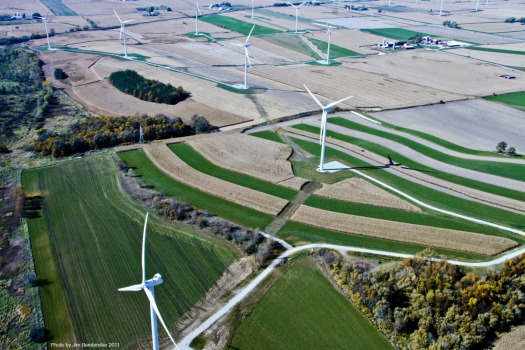
 Photo by Jim Bembinster, 2011 We Energies Glacier Hills wind project, Columbia County WI
Photo by Jim Bembinster, 2011 We Energies Glacier Hills wind project, Columbia County WI
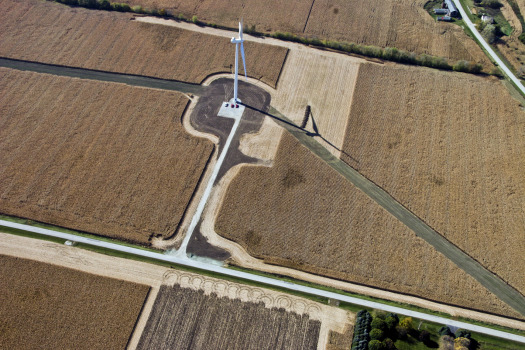
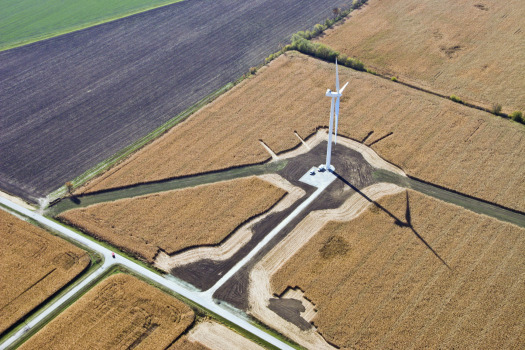

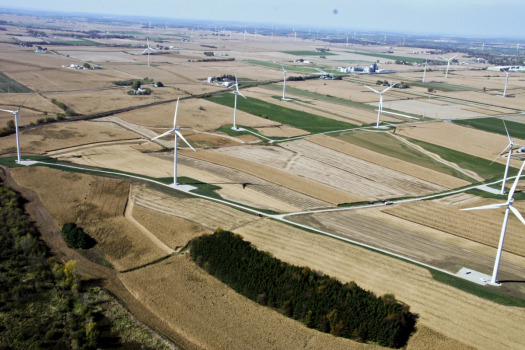
FROM ILLINOIS
FARMER UPSET WITH WIND COMPANY
BY DAVID GIULIANI, www.saukvalley.com 7 November 2011 ~~
COMPTON – Gale Barnickel, a Compton farmer, says he’s not against the wind farm being built in his area.
He and his parents decided against having turbines on their farm, but he said they respected the rights of others to have them.
“We have no problems with what the neighbors want,” he said.
Now, he is alleging that wind energy company Goldwind USA has been repeatedly trespassing on his family’s property. And that has resulted in crop damage, he said.
The property is well posted, he said, so trespassers knew what they were doing.
He brought the allegations to last week’s meeting of the county Zoning Board of Appeals, which is recommending changes to the county’s wind energy ordinance.
On Sunday, Goldwind admitted that its contractor mistakenly crossed into Barnickel’s land.
“When they realized this, they contacted Mr. Barnickel to apologize and address the issue,” spokesman Colin Mahoney said in a statement.
Since then, he said, the contractor has taken “concrete steps” to clearly mark Barnickel’s land, so it’s more visible to construction crews.
At last week’s meeting, those attending expressed concern about Barnickel’s situation. Another wind company weighed in, saying such things shouldn’t happen.
Goldwind, a subsidiary of a Chinese company, is putting up 71 turbines in an area of roughly 6 square miles near Compton in eastern Lee County. It hopes to finish the project – known as Shady Oaks – by year’s end.
In September, a farmer reported that the company had built a road through his cornfield that, he said, was unnecessary. He and another farmer pointed out roads and easements that, they contend, the company mistakenly built through faulty planning.
Other paths for transmission lines were curved, when a straight line would have taken out less cropland, they said.
Unlike Barnickel, those farmers allowed wind turbines on their property, which means they’ll get money every year from the company. In the contracts, Goldwind has agreed to compensate farmers for cropland lost in the construction project.
Barnickel has no agreement with Goldwind.
“Something has to be done to control these guys,” he said. “We try to be neighborly, but we’ve caught them mowing down our crops. They’re cutting corners wherever they can.”
Board member Tom Fassler asked Barnickel whether he had called authorities. The farmer said he had filed two reports with the Lee County Sheriff’s Department, but that it was a waste of taxpayers’ money to keep calling out the sheriff.
“It’s nerve-wracking being pushed around,” Barnickel said. “Why should I have to put up with that?”
“You shouldn’t,” Fassler responded.
Franklin Grove Village President Bob Logan, who attended the Zoning Board meeting, said that was what happens when wind farms are rushed through.
“You’re seeing the rush in the southern part of the county,” he said.
Logan warned that the county may face class-action lawsuits because “rights aren’t being respected.”
“It’s not a level playing field,” he said. “We are here to level it.”
John Martin of Mainstream Renewable Power, which plans a three-county wind farm, told Barnickel that “it’s just not right. No company should operate like this.”
The next day, Barnickel’s wife, Christina Barnickel, said in an interview that the state should fine companies that trespass.
“We have tried to stop them and showed them where the property line is,” she said. “You put so much hope and investment in the crop, and then someone knocks it over. It rubs you wrong.”
Mahoney said the company would continue to work hard to make sure it is a responsible neighbor throughout the rest of the project. He noted that the project is complex, with more than 100 workers busy building access roads, erecting turbines and delivering components on site.
“Despite this complexity, Goldwind is committed to minimizing the impact on the local community, including both participating landowners and neighboring landowners alike.”
NEXT FEATURE:
FROM WISCONSIN
More images of field fragmentation in the Columbia County We Energies wind project.
Photos by Jim Bembinster, 2011
